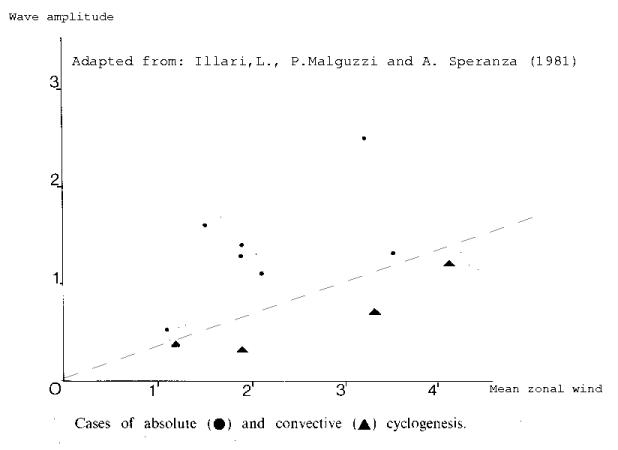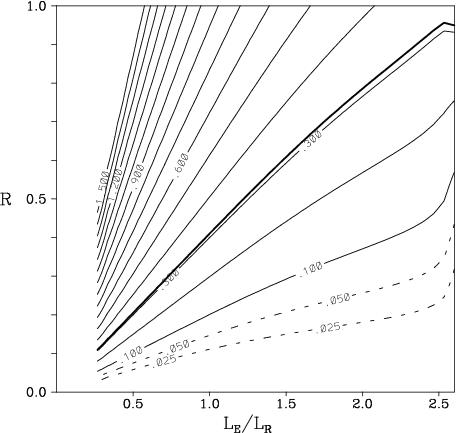Stability of atmospheric flows
Absolute and convective instability

Figure 1: Classification of observed and
numerically simulated cases
of orographic cyclogenesis [1]
and a possible transition threshold (dashed line).
and a possible transition threshold (dashed line).
- Poster (jpg - 754k)
- Time evolution Mode 1
- Time evolution Mode 2
Instability of finite amplitude lower-neutral Eady waves

Figure 2: Contours of the non-dimensional growth rate of the Mode 2 of
Fantini and Davolio (2001) as a function of non-dimensional wavelength
and maximum meridional velocity of the primary Eady wave. Thick line is
the value 0.31, the maximum Eady growth rate (see [3] for details).
Fantini and Davolio (2001) as a function of non-dimensional wavelength
and maximum meridional velocity of the primary Eady wave. Thick line is
the value 0.31, the maximum Eady growth rate (see [3] for details).

for absolute instability to develop.
Work in progress
Further research is needed to relate the observational/case-studies evidence (Figure 1) to the analytic/idealized-modeling results (Figure 2). A partial list of what we are working on:- Extract from observed orographic cyclogenesis cases the parameters of mean flow and "primary" wave needed to combine the "empirical" classification of Fig.1 with the theory of Fig.2.
- Extend the domain of the theoretical resuls of Figure 2 from two-dimensional neutral Eady waves to flow configurations closer to the observed atmosphere (spherical domain, deepening large-scale wave, frontal structure)
- Prove the "absolute" behavior of packets of Mode 2 waves from the truncated spectral series solution of [3].
References
[1] Illari, Malguzzi and Speranza, 1980: On breakdowns of the westerlies, Geophys. Astrophys. Fluid Dyn., 17, 27-49[2] Fantini and Davolio, 2001: Instability of neutral Eady waves and orography, J. Atmos, Sci., 58, 1146-1154
[3] Fantini, 2006: Instability of finite amplitude lower-neutral Eady waves. Quart. J. Royal Met. Soc., 132, 2157-2170.